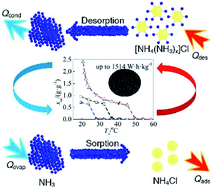An advanced composite sorbent with high thermal stability and superior sorption capacity without hysteresis for a better thermal battery†
Abstract
Efficient thermal energy harvesting utilizing composite sorbents has great potential for cost-effective energy storage applications; however, serious hysteresis and average sorption capacity are persistent bottlenecks for low-heat-loss and high-power-density thermal energy storage. Herein, three strategies for the synthesis of stable composites of ammonium chloride and expanded natural graphite treated with sulfuric acid (ENG-TSA) are reported. Among the three kinds of composites obtained by immersing ENG-TSA and NH4Cl in water (EWNs), the composite with the simplest mechanical stirring treatment (EWN-Mec) presented the highest thermal stability and could even maintain about 90% initial mass of NH4Cl after being heated at 180 °C for 40 h. The XRD patterns and FTIR spectrum of only EWN-Mec exhibit all main diffraction peaks and characteristic wavenumbers of ENG-TSA and NH4Cl, which demonstrate that magnetic stirring and ultrasonic treatment have a negative effect on the valid distribution of NH4Cl particles in the composites as they destroy the organized layers of ENG-TSA and reduce the dispersive force. SEM images indicate that the NH4Cl particles in the range of 38–177 nm are distributed in the lamellar structure of ENG-TSA in EWNs. EWN-Mec was chosen for further ammonia sorption tests due to its higher global thermal stability, better distribution of NH4Cl particles and lower cost of fabrication and future applications as compared to the case of other EWNs. Its ammonia sorption characteristics indicate multi-stage sorption, negligible hysteresis, and a superior sorption capacity of 2.41 g g−1, which is 96% higher than the highest ammonia sorption capacity reported to date. The resulting highest theoretical energy storage density of EWN-Mec (up to 1514 W h kg−1) is comparable to that of a state-of-the-art lithium-ion battery. Furthermore, thermodynamic and kinetic models were established to better understand the mechanism of the combination of solid adsorption and chemical reaction. The simple production process indicates that EWN-Mec can be easily engineered into devices for high-power-density and low-cost thermal energy storage applications.



 Please wait while we load your content...
Please wait while we load your content...